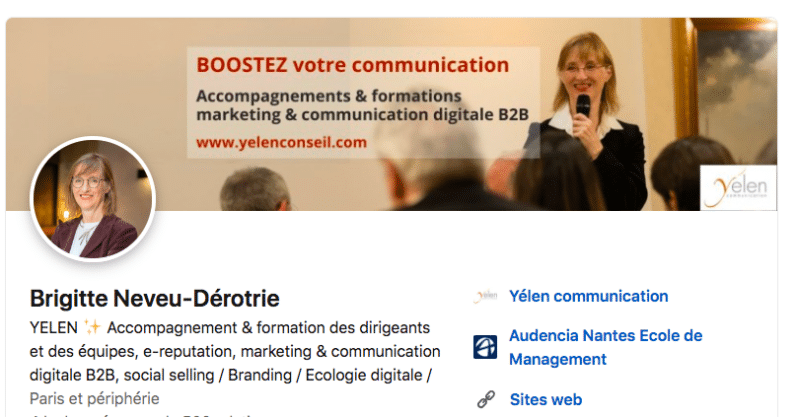Social selling and integrating LinkedIn into your business development strategy is a priority. It enables companies to improve their performance and offer their services more effectively for sale. In an increasingly connected and competitive environment, social selling brings new opportunities and more leads, and strengthens the brand image and proximity with customers and prospects. So what are the best practices to be aware of on LinkedIn if you want to sell well? Brigitte Neveu-Dérotrie, digital marketing expert, explains.

With 29 million members in France at the start of 2024, and growth of more than 20 % in two years, France is the 5th country with the most members on LinkedIn, behind the United States, India, Brazil and the United Kingdom.
More than 84 % of B-to-B decision-makers (executives from VSEs, SMEs, ETIs and large companies) use LinkedIn as part of their professional activity (source Digimind, 2020).
The social networks have completely revolutionised traditional sales techniques, enabling companies and salespeople to engage in conversation directly with their customers and prospects. Combined with technologies such as CRM systems, they have delivered a dynamic experience, focused on building long-lasting, trusting relationships with customers.
What is social selling?
Social selling is of interest to everyone in the business world, particularly in the B-to-B sector - from sales representatives to managers and entrepreneurs - who are looking to strengthen their position in the marketplace. development strategy using social networksFirst and foremost, LinkedIn. It is mainly on this network that you will be able to forge and maintain links with your prospects, customers and partners.
Social selling is a logical response to the digital evolution of commercial practices.
Born of the convergence between traditional sales techniques and social platforms, social selling can provide powerful support for sales activity and is part of a modern approach to customer relationship management (CRM, inbound marketing...). It enables salespeople to be in contact with the right people at the right time, by offering them tailored content.
The four essential steps to success
- Clearly define your professional positioning
- Building a compelling and attractive profile
- Generate a steady stream of new contacts and prospects through new connections
- Be active, engage and interact with your network
1. Define your objectives and your professional positioning
Your LinkedIn strategy should reflect your professional ambitions. Make your objectives and value proposition explicit, specific and differentiating.
Two examples
- If you are an information systems consultant, your profile can highlight your expertise in optimising IT processes and digitalising businesses.
- If you are a salesperson, your strategy will naturally be adapted and consistent with that of your company.
2. Build an attractive profile
An optimised LinkedIn profile starts, of course, with a professional-quality photo that conveys confidence and professionalism. The same goes for the background banner.

The wording of the title is very important. The title must be engaging. It is the title that appears in searches, but also in your contributions, posts and comments, in particular. The title needs to have substance, incorporating your value proposition, your expertise and your key areas of competence. For example: digital transformationa specialist in IT security, employee experience and employer brand.
Don't forget to look for complementary keywords that could help you stand out on the platform's search engine and highlight your expertise.
For example, if you have the "CRM" skill, analyse the profiles that stand out the most. Also study the other suggested queries on LinkedIn. In this case: "CRM manager, CRM director, CRM head, CRM consultant".
Your biography ("Info" section) should act as a sales pitch. It's not a history of your career, but a presentation of who you are and, above all, what you can offer your target audience.
For example: a sales manager will explain how he has transformed his teams' sales performance thanks to innovative strategies.
Finally, make the most of the other possibilities offered by the platform by incorporating your key areas of expertise: highlighting content and presentation on "My selection", professional experience, training, recommendations, etc. Not forgetting, of course, your contact details so that we can get in touch with you.
The key elements of your profile
- A professional photo and an engaging banner
- An optimised title
- An eye-catching biography ("news section")
- All the sections of your profile optimised (experience, training, recommendations, volunteering, etc.)
3. Developing new connections
Social selling is a daily practice and LinkedIn encourages you to develop your network. Take the time to connect with new profiles, especially those in industries or functions that complement yours.
For example, a B-to-B marketing manager could target innovation directors in the clean technology sector to expand his network and explore new business opportunities.
Also think about the communities and peer groups you can join to gain visibility and provide mutual support. Be generous with your network, react and comment on relevant content.
4. Interacting with your network: strategic commitment
Publishing regularly and consistently increases your visibility and confirms your position as a reference in your field. Try not only to add value, but also to maintain the link and engagement with your audiences.
Share case studies, thoughts on market trends or customer success stories that highlight your approach and results. Short of time? Take at least a few minutes each day to comment on publications in your field. And don't forget to ask for support from your colleagues and partners when you're making important publications, to give them a boost.
Advanced use of LinkedIn
Understand and track your Social Selling Index (SSI) to measure your effectiveness on the platform. Use advanced search filters to identify qualified leads or integrate Sales Navigator for even more precise targeting.
This software enables you, for example, to track changes in company teams and new appointments, which are potential sales opportunities.
Good practice
Regularly check your score on the Social Selling Index. This will show you the levers on which you are most effective and those you need to strengthen.
More than just a tool, social selling is an invaluable accelerator for salespeople and a transformation of traditional sales methods. What are your company's best practices in this area? ORSYS offers a complete range of training courses in this area. Are you ready to take up the challenge?





